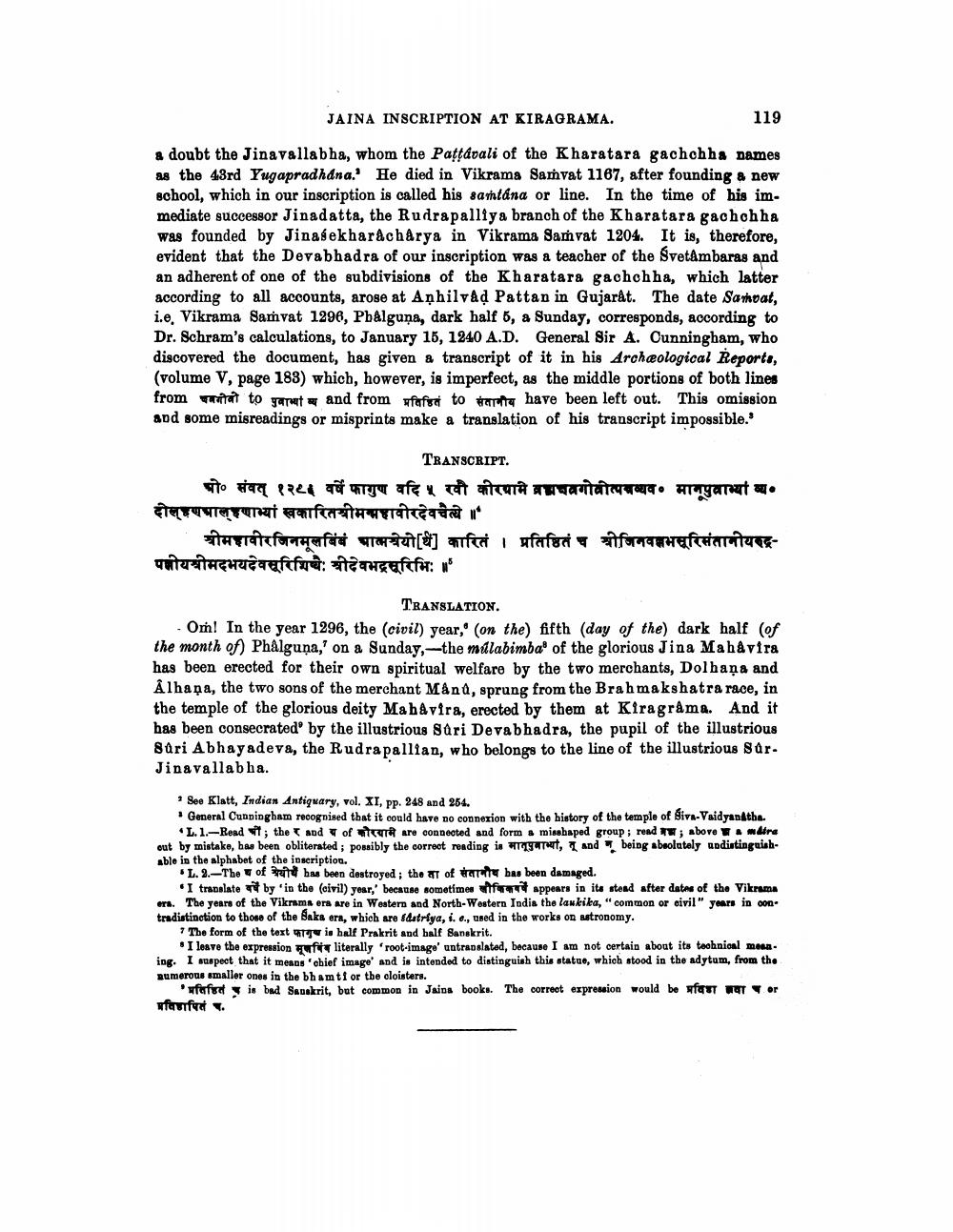________________
JAINA INSCRIPTION AT KIRAGRAMA.
119
a doubt the Jinavallabha, whom the Paṭṭávali of the Kharatara gachchha names as the 43rd Yugapradhana.' He died in Vikrama Samvat 1167, after founding a new school, which in our inscription is called his samtána or line. In the time of his immediate successor Jinadatta, the Rudrapalliya branch of the Kharatara gachchha was founded by Jinasekharacharya in Vikrama Samvat 1204. It is, therefore, evident that the Devabhadra of our inscription was a teacher of the Svetâmbaras and an adherent of one of the subdivisions of the Kharatara gachchha, which latter according to all accounts, arose at Anhilvâḍ Pattan in Gujarât. The date Samvat, i.e. Vikrama Samvat 1296, Phalguna, dark half 5, a Sunday, corresponds, according to Dr. Schram's calculations, to January 15, 1240 A.D. General Sir A. Cunningham, who discovered the document, has given a transcript of it in his Archeological Reports, (volume V, page 188) which, however, is imperfect, as the middle portions of both lines from wबगोजो to पुवाभ्यां व्य and from प्रविष्ठितं to संतानीय have been left out. This omission and some misreadings or misprints make a translation of his transcript impossible.
TRANSCRIPT.
० संवत् १२८६ वर्षे फागुण यदि ५ रवौ कीरचामे ब्रह्मचवगोवीत्पचव्यय मानूपुवायां व्य दोल्हणआल्हणाभ्यां स्वकारितश्रीमन्महावीरदेवचैत्ये ॥
श्रीमहावीर जिनमूलविंवं पाकवेयो] [] कारितं । प्रतिष्ठितं च श्रीजिनवज्ञभरिसंतानीयरुद्रपक्षीयश्रीमदभयदेवसूरिशिष्येः श्रीदेवभद्रसूरिभिः ॥
TRANSLATION.
Om! In the year 1296, the (civil) year," (on the) fifth (day of the) dark half (of the month of) Phalguna,' on a Sunday,-the malabimba" of the glorious Jina Mahavira has been erected for their own spiritual welfare by the two merchants, Dolhana and Alhana, the two sons of the merchant Mâna, sprung from the Brahmakshatra race, in the temple of the glorious deity Mahavira, erected by them at Kiragrâma. And it has been consecrated by the illustrious Suri Devabhadra, the pupil of the illustrious Suri Abhayadeva, the Rudrapallian, who belongs to the line of the illustrious SurJinavallabha.
2 See Klatt, Indian Antiquary, vol. XI, pp. 248 and 254.
General Cunningham recognised that it could have no connexion with the history of the temple of Siva-Vaidyanatha. L. 1.-Read; the and of are connected and form a misshaped group; read ; above a máira out by mistake, has been obliterated; possibly the correct reading is great, and being absolutely undistinguishable in the alphabet of the inscription.
L. 2.-The of has been destroyed; the aT of art has been damaged.
I translate by 'in the (civil) year,' because sometimes fa appears in its stead after dates of the Vikrama era. The years of the Vikrama era are in Western and North-Western India the laukika, "common or civil" years in con. tradistinction to those of the Saka era, which are sdstriya, i. e., used in the works on astronomy.
7 The form of the text arg is half Prakrit and half Sanskrit.
I leave the expression af literally root-image' untranslated, because I am not certain about its technical meaning. I suspect that it means 'chief image' and is intended to distinguish this statue, which stood in the adytum, from the numerous smaller ones in the bham ti or the cloisters.
* प्रतिष्ठितं च is bad Sanskrit, but common in Jains books. The correct expression would be प्रविधा नवा च or प्रविधापितंच.




